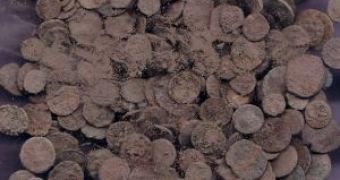Dutch archaeologists have found about 200 silver Roman coins, several jewels, an armband and a ring in a clay pot during a digging near the city of Cuijk, close to Maas river, 80 miles southeast of Amsterdam.
The finds were made while excavating in an area where new housing was to be built.
Till now, the treasure from the clay pot was examined only with x-rays.
A first coin removed and cleansed is from the time of the eccentric Roman emperor Elagabalus, whose reign lasted from 218 to 222 A.D.
"During the uncovering of the pot, it became apparent that it was placed precisely at the spot where a bolt of lighting struck," said archaeologists.
"Further study will have to determine whether ... the pot could have been buried as an offering, or if the inhabitants by chance had left these valuables hidden in this spot for fear of theft."
The coins are thought to have been given in payment to loyal Germanic tribes.
In the same area, known as "De Nielt," Stone Age settlements were found.
Romans first reached this are during Julius Caesar around 53 B.C., but only in the first century A.D. They succeeded to secure the area south of the Rhine River in southern current Netherlands.
The ancient people living there must have been the Germanic tribe of the Batavians.
Starting with the end of the third century A.D., De Nielt was run by German tribes from outside the empire, like the Franks (Dutch language is derived from their language), and parts of the settlement adopted the German building style.
The wet area was left after that, inhabited again briefly in the early Middle Ages, and was again abandoned by its inhabitants.
The field excavation of the Roman-era settlement is almost complete and it will take no more of three months to be finished.

 14 DAY TRIAL //
14 DAY TRIAL //